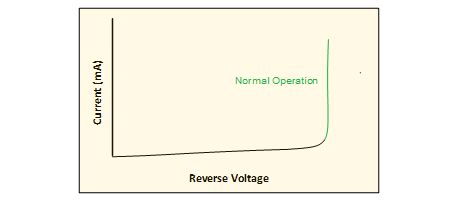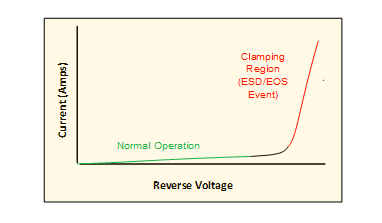I cannot tell you how many times I have heard this in reference to silicon-based Transient Voltage Suppressors (TVS). In all fairness, TVS manufacturers have probably perpetuated this notion. After all, we usually refer to these devices as TVS diodes or electrostatic discharge (ESD) protection diodes. Technically, a diode is a two terminal device that conducts current primarily in one direction. A TVS, or TVS diode, is a two terminal device that is designed to conduct current in the reverse breakdown region. However, calling it “just a diode” implies any TVS diode, or any diode type for that matter, can be effortlessly chosen and relied upon to protect your circuit. Following this assumption will most likely lead to disappointing results.

As design geometries shrink and bus speeds continue to increase, engineering TVS diodes is more challenging than ever. Most modern TVS devices are intricate and multi-junction, designed for specific applications. The schematic symbol is the same but the internal circuit is more elaborate. Figure 1 is an example of a low capacitance, deep snapback TVS device. Definitely not “just a diode.” Let’s take a closer look.
 Figure 1 – TVS Structure Example © Semtech Corporation
Figure 1 – TVS Structure Example © Semtech Corporation

What is a TVS Diode Anyway?
One common misconception is that TVS diodes and Zener diodes are the same thing, and I often hear TVS diodes referred to as “Zeners”. TVS diodes and Zener diodes are engineered for very different applications. Zener diodes are designed to regulate voltage and therefore operate in the breakdown region (Figure 2).
 Figure 2 – Zener Diode Operating Region © Semtech Corporation
Figure 2 – Zener Diode Operating Region © Semtech Corporation
TVS diodes are devices specifically designed to suppress transient overvoltage events. Under normal operating conditions, a TVS presents a high impedance to the protected circuit. The only current that flows is due to the leakage current of the device, normally a few nanoamps. TVS diodes conduct when a transient voltage exceeds the breakdown voltage of the device (Figure 3).
 Figure 3 – TVS Operating Region © Semtech Corporation
Figure 3 – TVS Operating Region © Semtech Corporation
TVS diodes dissipate high energy for a short period. Transient events last anywhere from a few nanoseconds up to about one millisecond. This requires larger junction areas that promote uniform current distribution and other design elements that ensure the device can absorb the expected energy without incurring damage.
TVS Parameters
TVS working voltage is defined as the voltage where the device appears as a high impedance to the circuit. TVS devices are normally chosen to have a working voltage as close to the circuit operating voltage as possible. During a transient event, the voltage on the protected line will quickly rise. Once the TVS breakdown voltage is exceeded, it becomes a low impedance path for conducting transient current. The voltage developed across the TVS under maximum transient current conditions is defined as the clamping voltage. This is a key but often overlooked parameter, as it is also the voltage across the protected circuit. If the maximum functional limits of the protected IC are exceeded, it will likely be damaged or destroyed. Protecting high speed circuits presents other design challenges, such as reducing the effective loading capacitance of the TVS without compromising its ability to conduct high-energy transients. In part two, we will examine various circuits that manufacturers use to reduce clamping voltage and effective capacitance, further illustrating the fact that TVS devices are not “just diodes.”

Semtech and the Semtech logo are registered trademarks or service marks of Semtech Corporation or its affiliates.

 Figure 1 – TVS Structure Example © Semtech Corporation
Figure 1 – TVS Structure Example © Semtech Corporation
 Figure 2 – Zener Diode Operating Region © Semtech Corporation
Figure 2 – Zener Diode Operating Region © Semtech Corporation Figure 3 – TVS Operating Region © Semtech Corporation
Figure 3 – TVS Operating Region © Semtech Corporation